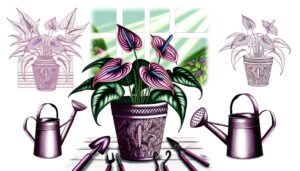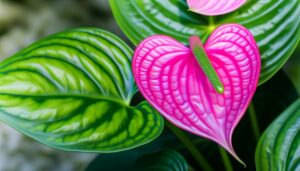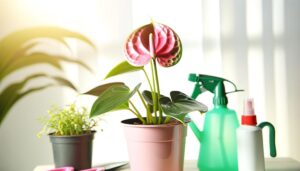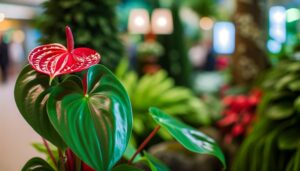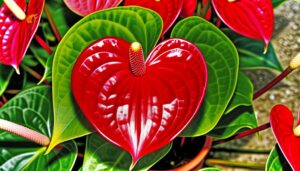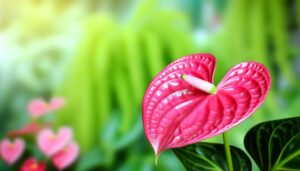Troubleshooting Common Red Anthurium Plant Problems
Troubleshooting your Red Anthurium starts with identifying key issues. Yellowing leaves often stem from improper watering or nutrient deficiencies; adjust soil pH and moisture.
Wilting or drooping can result from overwatering, insufficient light, or root problems. Ensure bright, indirect light and check soil moisture.
Brown leaf tips indicate erratic watering or low humidity—maintain steady moisture. Lack of blooms points to insufficient light or nutrients; optimize both.
Fungal infections cause leaf spots—improve air circulation and water management. Root rot, due to excessive watering, requires better drainage and reduced frequency.
For deeper insights into each solution, stay tuned.
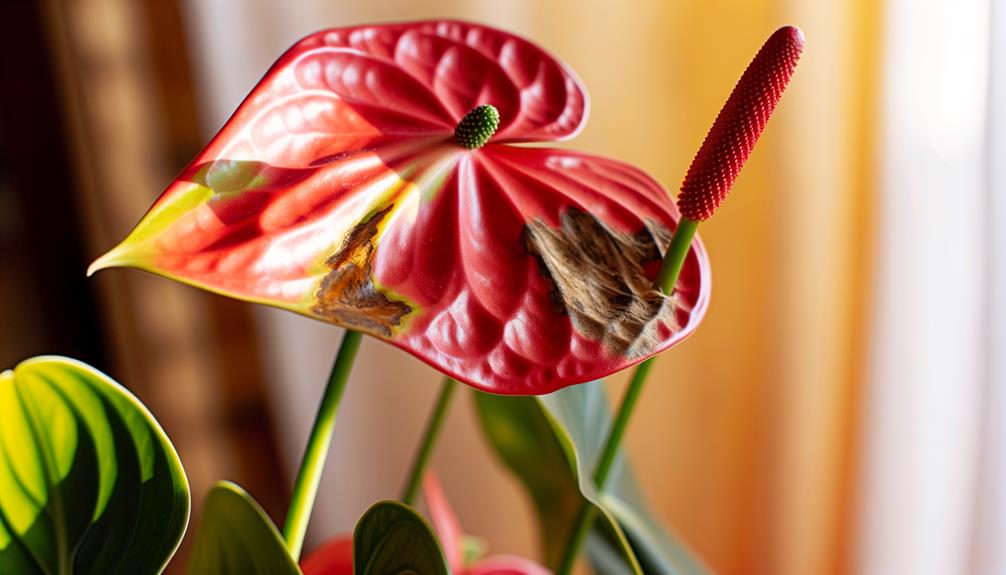
Key Takeaways
- Ensure proper watering: Keep soil moist but not waterlogged to prevent root rot and dehydration.
- Provide bright, indirect light: Avoid direct sunlight to prevent leaf damage and ensure adequate light for blooming.
- Maintain root health: Use well-aerated soil mix and ensure proper drainage to avoid root rot.
- Address nutrient deficiencies: Regularly check soil pH and supplement with necessary nutrients to prevent yellowing leaves and brown tips.
- Improve air circulation: Adjust watering practices and increase airflow to prevent fungal and bacterial infections causing leaf spots and blotches.
Yellowing Leaves
Yellowing leaves on your red anthurium often indicate improper watering, nutrient deficiencies, or pest infestations. Make sure you're not overwatering; the soil should be moist but not waterlogged. Excess water can cause root rot, leading to chlorosis.
Check your soil's pH; anthuriums prefer a slightly acidic environment (pH 5.5-6.5). Nutrient-deficient soils—particularly lacking nitrogen, magnesium, or iron—result in yellowing. Use a balanced, water-soluble fertilizer and monitor your plant's response.
Examine leaves for pests like aphids, spider mites, or mealybugs. These insects sap nutrients and cause discoloration. Neem oil or insecticidal soap can effectively eliminate infestations.
Regularly inspect your plant's environment for consistent humidity and temperature, as fluctuations can worsen yellowing. Address these factors promptly for vibrant, healthy foliage.
Wilting or Drooping
When you notice your Red Anthurium wilting or drooping, you should first evaluate your watering regimen, as both overwatering and underwatering can stress the plant.
Assess the light conditions, ensuring your plant receives bright, indirect light, as poor light exposure can lead to weakened stems.
Additionally, inspect the root system for signs of rot or compaction, which can impede nutrient uptake and lead to drooping foliage.
Inadequate Watering Practices
Improper watering practices can lead to wilting or drooping in Red Anthurium plants, as these tropical plants require consistently moist but not waterlogged soil to thrive. When you overwater, the roots suffocate due to lack of oxygen, leading to root rot.
Conversely, underwatering results in insufficient hydration, causing cellular dehydration and loss of turgor pressure. Monitor soil moisture levels using a hygrometer; aim for soil that feels like a wrung-out sponge.
Ensure proper drainage to prevent standing water, which exacerbates root diseases. Incorporate a well-aerated potting mix containing perlite or orchid bark to improve soil structure.
Poor Light Exposure
In addition to balanced watering, ensuring adequate light exposure is critical for preventing wilting or drooping in Red Anthurium plants. Red Anthuriums thrive in bright, indirect light. Direct sunlight can scorch their leaves, while too little light can lead to leggy growth and weak stems.
To enhance light conditions:
- Placement: Position your plant near an east or west-facing window to capture sufficient indirect sunlight.
- Artificial Lighting: Use grow lights if natural light is insufficient, ensuring they're on for about 12-14 hours daily.
- Light Intensity: Measure light intensity using a light meter, aiming for 10,000 to 20,000 lux for optimal growth.
Root Health Issues
Addressing root health issues in Red Anthuriums involves closely monitoring the soil's moisture levels and ensuring proper drainage to prevent root rot, which can lead to wilting or drooping. You should use a well-aerated, chunky soil mix, rich in organic matter, to facilitate ideal root respiration.
Consistently overwatering can cause anaerobic conditions, promoting pathogenic fungi like Pythium and Phytophthora. Observe your plant's roots; healthy roots are firm and white, while infected roots appear brown and mushy. If root rot is detected, trim away affected roots with sterilized scissors and repot the plant in fresh soil.
Implement a balanced watering regimen, allowing the top inch of soil to dry out between waterings to sustain long-term root health and plant well-being.
Brown Leaf Tips
Brown leaf tips on your red Anthurium plant often indicate issues with watering practices, humidity levels, or nutrient deficiencies. To address this, you need a precise approach:
- Watering Practices: Overwatering or underwatering can cause tip browning. Guarantee the soil is consistently moist but not waterlogged. Utilize a well-draining potting mix to avoid root rot.
- Humidity Levels: Anthuriums thrive in high humidity (70-80%). If your environment is dry, use a humidifier or place the plant on a pebble tray with water to increase ambient moisture.
- Nutrient Deficiencies: Lack of essential nutrients like potassium or magnesium can cause brown tips. Regularly feed your Anthurium with a balanced, water-soluble fertilizer, following the manufacturer's instructions for dosage.
Paying close attention to these factors will help restore your Anthurium's vibrant health.
Lack of Blooms
When your Red Anthurium isn't blooming, you should first assess the light conditions, as insufficient light can inhibit flower production.
Next, evaluate your watering practices, ensuring you're not overwatering or underwatering, as both extremes stress the plant.
Insufficient Light Conditions
Have you noticed that your anthurium isn't blooming as it should be? Insufficient light is a common culprit. Anthuriums require bright, indirect light to thrive and produce their signature blooms.
Here's how to troubleshoot:
- Light Intensity: Guarantee your plant receives at least 2000-2500 foot-candles of light. Too low, and photosynthesis won't support blooming.
- Light Duration: Provide 10-12 hours of light daily. Use full-spectrum grow lights if natural light is inadequate.
- Light Quality: Avoid direct sunlight, which can cause leaf scorch. Instead, place your anthurium near an east or north-facing window.
Improper Watering Practices
Aside from insufficient light, improper watering practices can also severely impact your anthurium's ability to bloom. Overwatering leads to root rot, depriving roots of essential oxygen, while underwatering results in dehydration and nutrient transport disruption. Both conditions stress the plant, inhibiting inflorescence development.
Guarantee the potting mix remains consistently moist but never soggy. Utilize well-draining soil and pots with adequate drainage holes. Water your anthurium when the top inch of soil feels dry to the touch. Employ room-temperature, filtered water to avoid chlorine and fluoride damage.
Monitor humidity levels, maintaining around 60-80%, as anthuriums thrive in humid environments. By refining these watering techniques, you'll enhance your plant's overall health, encouraging vibrant blooms.
Nutrient Deficiency Issues
Nutrient deficiencies, particularly in essential elements like nitrogen, phosphorus, and potassium, can greatly hinder anthurium flowering. When your anthurium lacks these nutrients, it struggles to produce those vibrant red blooms you love.
To address this, consider the following:
- Nitrogen: Essential for leaf and stem growth. Without it, your plant may appear stunted and pale.
- Phosphorus: Necessary for root development and blooming. A phosphorus deficiency leads to fewer flowers and weaker roots.
- Potassium: Improves overall plant health and flower quality. Inadequate potassium results in poor flower formation and weak stems.
Regularly use a balanced fertilizer to guarantee your anthurium receives these nutrients. Monitor the plant's response and adjust as necessary to maintain vibrant blooms.
Pests and Diseases
Why do common pests and diseases pose significant threats to the health and well-being of your red anthurium plant? Pests like aphids, spider mites, and mealybugs can sap nutrients, causing stunted growth and weakened resistance. Diseases, particularly fungal and bacterial infections, thrive in high humidity, leading to root rot and wilting.
| Common Pests | Symptoms | Treatment |
|---|---|---|
| Aphids | Curling leaves, sticky sap | Insecticidal soap, neem oil |
| Spider Mites | Webbing, yellow spots | Miticide, increase humidity |
| Mealybugs | Cottony masses, sooty mold | Rubbing alcohol, horticultural oil |
Regularly inspect your anthurium's leaves and stems. Early detection and proper treatment are essential. Maintaining ideal humidity and cleanliness can prevent many issues before they escalate.
Leaf Spots and Blotches
Leaf spots and blotches on your red anthurium often indicate fungal or bacterial infections, typically resulting from excessive watering or poor air circulation.
To diagnose and manage these issues, consider the following steps:
- Identify the Pathogen: Examine the spots. Fungal infections usually present as circular, water-soaked lesions, while bacterial spots appear angular and oily.
- Adjust Watering Practices: Confirm the soil is well-draining and only water when the top inch is dry. Excessive watering creates a conducive environment for pathogens.
- Improve Air Circulation: Space plants adequately and use a fan if necessary. Stagnant air fosters microbial growth.
Root Rot Concerns
Root rot in red anthuriums is primarily caused by excessive watering and poorly draining soil, leading to fungal infection and subsequent decay of the plant's root system. To identify root rot, inspect the roots for a brown, mushy texture and a unpleasant odor. Proper diagnosis is essential for effective treatment.
| Symptom | Description |
|---|---|
| Discolored Leaves | Yellowing or browning |
| Wilting | Drooping despite watering |
| Root Appearance | Brown, mushy texture |
| Foul Odor | Unpleasant smell |
To combat root rot, decrease watering frequency and enhance soil drainage. Consider repotting your anthurium with a well-draining mix, such as one containing perlite and orchid bark. Make sure your pot has sufficient drainage holes. This careful attention maintains your cherished plant's health.
Conclusion
In caring for your red anthurium, you'll find that diagnosing yellowing leaves is as important as celebrating its vibrant blooms.
While wilting signals hydration issues, thriving stems showcase your success.
Brown leaf tips might frustrate, but lush greenery rewards your diligence.
Lack of blooms can be challenging, yet each flower is a proof of your efforts.
Pests threaten, but a healthy plant stands resilient.
Addressing leaf spots and root rot guarantees your anthurium flourishes.
Therefore, mastering these challenges cultivates your botanical expertise.

